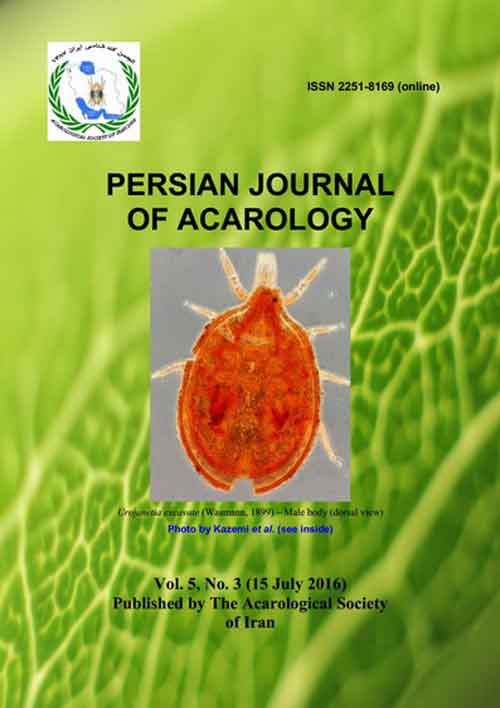فهرست مطالب

Persian Journal of Acarology
Volume:5 Issue: 3, Summer 2016
- تاریخ انتشار: 1395/07/30
- تعداد عناوین: 8
-
-
Page 161In this present paper six new mite species of the family Phytoseiidae (Acari: Mesostigmata) are described from Arunachal Pradesh, India: Euseius arunachalensis sp. nov., E. bandispermathecae sp. nov., E. bomdilae sp. nov., Typhlodromus (Anthoseius) dahungensis sp. nov., Phytoseius dorsospinosus sp. nov. and P. leopardisimilis sp. nov.Keywords: Euseius, female, Mesostigmata, Phytoseius, taxonomy, Typhlodromus (Anthoseius)
-
Page 189In the course of a faunistic survey of oribatid mites (Acari: Oribatida) from the biosphere reserve Dasht-e Arjan and Parishan, and Chehel Cheshmeh region (Fars Province) during 20142015, a total of 91 species belonging to 68 genera and 43 families were collected and identified. Among them, one genus and seven species were recorded for the first time for the mite fauna of Iran.Keywords: Fauna, new record, Sarcoptiformes, southern Iran, taxonomy
-
Page 207Herein, two genera, Urodiaspis Berlese and Urojanetia Berlese, and four species, Trachyuropoda hirschmanni Pecina, 1980, Urodiaspis tecta (Kramer, 1876), Urodiaspis pannonica Willmann, 1951 and Urojanetia excavata (Wasmann, 1899), are reported for the first time from Iran. Additionally, Urodiaspis pannonicasimilis Bal and Özkan, 2009 is considered as junior synonym of U. pannonica, and new morphological data for this species represented.Keywords: Fauna, Monogynaspida, new synonym, soil inhabiting mites, Uropodoidea
-
Page 219The purpose of this study was to determine the frequency, diversity and seasonal distribution of ticks collected from camels (Camelus dromedarius) in Sistan and Balouchestan region, southeast of Iran. Totally, 139 camels (74 females and 65 males) were randomly selected from May, 2014 to April, 2015, out of which 75 camels (53.9%) were found to be infested by ticks. Out of the examined ticks, eight species of two genera (Hyalomma and Rhipicephalus) were identified, namely Hyalomma dromedarii (39.5%), Rhipicephalus sanguineus (16.1%), H. anatolicum (14.1%), H. excavatum (11.7%), H. schulzei (6.4%), H. scupense (5.5%), R. turanicus (4.7%), and H. asiaticum (2%). The prevalence of ixodid tick infestation was higher in the female camels (60.8%) than the males (46.1%) (P > 0.084). The number of the hard ticks found on 12 year old female camels (76.9%; 30/39) was higher than on the other age groups (PKeywords: Camels, hard ticks, Hyalomma, Iran, Rhipicephalus, Sistan, Balouchestan
-
Page 229The litchi white rust mite, Notacaphylla chinensiae Mohanasundaram and Singh, 1988 is a pest of litchi in West Bengal, India. Study on population dynamics, sensitive-ness of litchi cultivars towards the mite was conducted between 2009 and 2011. The mite remains active on litchi plants throughout the year in West Bengal, reaching the highest population densities (1300 to 1500 mites/cm2 leaf) in winter (January/ February). Population densities of N. chinensiae was negatively correlated with monthly mean of the maximum temperature (0.492), minimum temperature (0.785), rainfall (0.665) and minimum humidity (0.829). Among 11 litchi cultivars, the highest mean population throughout the year was recorded on Nafarpal (440584 mites/cm2 leaf) followed by Elaichi (431597 mites/cm2 leaf), Bombai (437600 mites/cm2leaf) and Seedless late (444594 mites/cm2 leaf), whereas the lowest was assessed on Purbi (146167 mites/cm2 leaf) followed by Muzaffarpur (148184 mites/cm2 leaf).Keywords: Cultivar susceptibility, litchi, India, weather parameters, white rust mite
-
Page 239The predatory mite, Neoseiulus barkeri Hughes is one of the most important phytoseiid mites to control phytophagous mites. The effect of different diets such as, corn pollen, walnut pollen, sunflower pollen, date pollen, bee pollen along with the two-spotted spider mite (Tetranychus urticae Koch) eggs on life table parameters of the predatory mite was determined on strawberry detached leaves in Petri dishes. The experiments were carried out under laboratory conditions at 27 ± 1°C, 16L: 8D h photo-period and 70 ± 5% RH. The individuals of the predatory mite were collected from cucumber field infested with the two-spotted spider mite of Khoramabad, Lorestan Province. The results indicated that mean preimaginal developmental time was the highest on sunflower pollen and bee pollen than the preimaginal developmental time on the other tested pollens. The developmental time of adult of N. barkeri when fed with bee pollen (10.0 and 9.25 days for female and male, respectively) is longer than when it fed on the other diets. The fecundity rate of predatory mite on different diets did not show any significant difference. The intrinsic rate of increase (r) of the predatory mites fed with sunflower pollen (0.212 d-1), date pollen (0.225 d-1) and corn pollen (0.224 d-1) were higher than the other treatments. With attention to observed results, corn pollen, sunflower pollen and date pollen were suitable alternative food for the mass rearing of this predator.Keywords: Life table, mass rearing, predatory mite, spider mite eggs, strawberry

